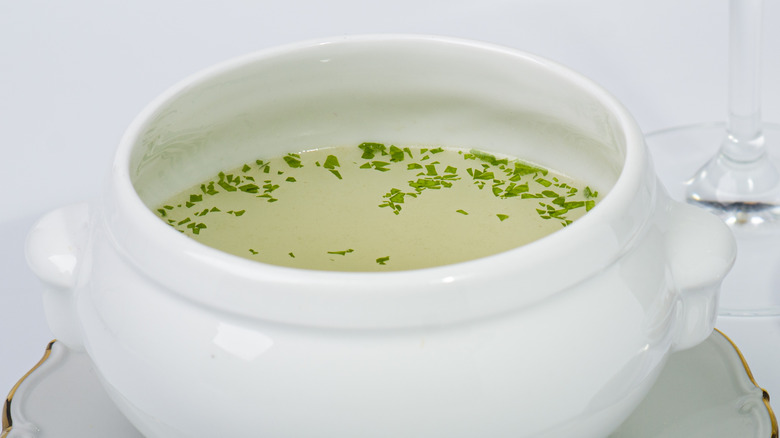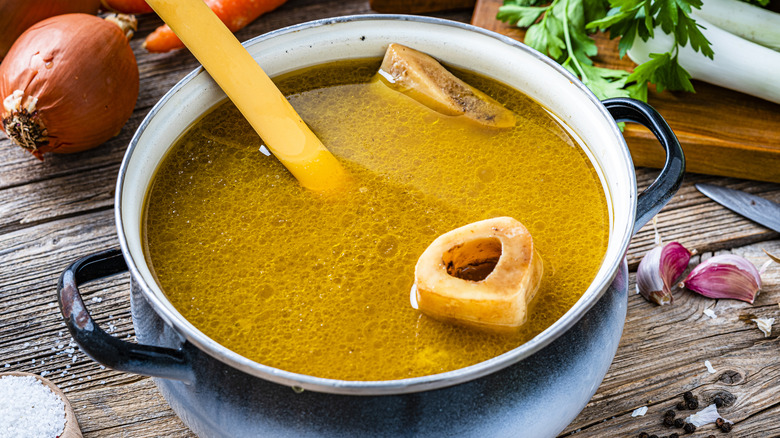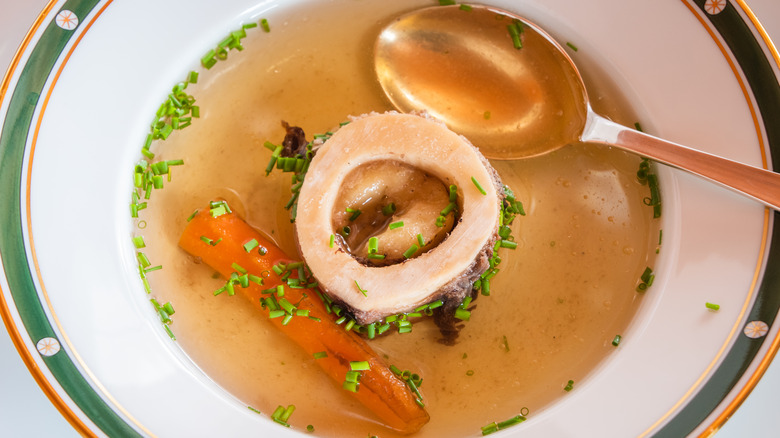The Important Differences Between Broth And Consommé
The difference between broth and consommé isn't so much their ingredients but the process by which one is transformed into the other. Consommé is a clarified soup reportedly invented by King Louis XIV of France. The story goes that he commanded his chef to make a soup that was so clear the King would be able to see his reflection in the bowl. Ever since, consommé has had an air of royalty and luxury.
Broth is a universally useful ingredient that has been used to flavor dishes and provide nourishment from Ancient Greece and China all the way up to the modern day. Drawing its rich flavor from a collection of animal bones, meat, aromatics, and vegetables, a good broth serves as a base for a consommé. When you compare the two, consommé cannot exist without broth. Broth, however, can get on just fine without consommé. The difference between them lies both in the clarity of the liquid and their respective uses.
The many uses of broth
Making broth is an incredibly simple process. Using your choice of chicken, beef, fish, or vegetables, throw all of the ingredients in a pot, cover it with water, and cook for several hours on the stove. What you'll get is a wonderfully flavorful, opaque liquid that serves as a base for numerous different dishes, including consommé. Broth can traditionally be made using bones with the meat still attached, but you can remove the cooked meat and save the bones for making bone broth.
We all know that the best use for any broth is as a base for soup, but it is much more versatile than that. You can add hot broth to mashed potatoes for elevated flavor and a creamier texture or even add it to eggs for an additional meaty and savory taste, whether poached or scrambled. Pasta will suck up broth like a sponge, especially if it's been cooked in it. Plus, the bone meal present in the liquid will help thicken the sauce and help it cling better to the pasta.
Broth is also excellent taken straight, like you would a cup of tea. Bone broth, in particular, is filled with easily digestible vitamins and nutrients, such as collagen, and will help keep you hydrated when you're sick, per CareNow. No matter how you use it, broth is important for any cook to learn how to make.
Clarity is the key to consommé
Transforming broth into consommé requires the use of whisked egg whites as a clarifying agent. The egg whites will form a lumpy foam raft at the top of the boiling broth. This raft acts as a filter by collecting any remaining solids in the broth and bringing them up to the top. A strong bone broth of veal, beef, chicken, or fish is the best base for consommé, as the gelatin rendered will yield a velvety, concentrated, crystal-clear liquid. However, fish and vegetables will yield a far lighter consommé.
Consommé is not traditionally presented in a way that will muddle its clarity. Served on its own, consommé makes for a warming first course or even as a light lunch. Garnishes, such as herbs, vegetables, and even meat, can be added but should be done so only at the last minute in order to maintain the soup's clarity.
One of the most iconic dishes to be made with consommé is aspic. Thanks to the gelatin rendered from the cooked bones in the broth, when consommé cools, it becomes a savory jelly. Though hardly as in vogue as it once was, there is hardly a way to be more culinarily and artistically expressive than a well-decorated aspic. If aspic isn't your thing, jellied consommé can easily be warmed back into a liquid state.


